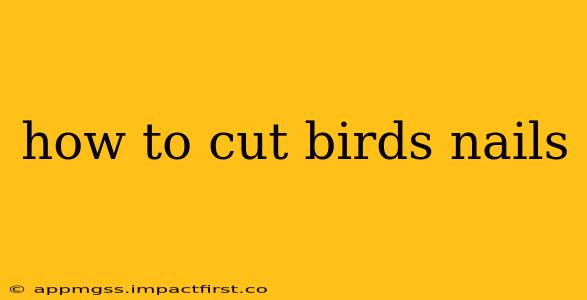Trimming your bird's nails might seem daunting, but with the right tools and techniques, it can be a safe and straightforward process. Regular nail trims are crucial for your feathered friend's health and well-being, preventing overgrown nails that can cause discomfort, injury, and even infection. This guide provides a step-by-step approach, addressing common concerns and ensuring a positive experience for both you and your bird.
What You'll Need:
- Sharp, small animal nail clippers: Avoid human nail clippers; they're too large and can easily crush the nail. Look for guillotine-style clippers specifically designed for birds or small animals.
- Styptic powder or pencil: This is essential to stop any bleeding if you accidentally cut the quick (the pink part of the nail containing blood vessels and nerves).
- Treats: Positive reinforcement is key! Have your bird's favorite treats readily available.
- Towel (optional): A towel can help restrain your bird gently if they're particularly fidgety.
- A helper (optional): Having an extra set of hands can make the process much easier, especially with larger or more resistant birds.
How to Cut Your Bird's Nails: A Step-by-Step Guide
-
Observe Your Bird's Nails: Before you begin, carefully examine your bird's nails. Identify the quick, the pink part of the nail containing blood vessels. You should only cut the clear, white part of the nail, beyond the quick. If the nails are dark, it can be harder to see the quick. In this case, it's best to trim small amounts at a time to avoid cutting the quick.
-
Choose the Right Time: Choose a time when your bird is calm and relaxed. Avoid trimming their nails right before bedtime or when they're already stressed or agitated.
-
Restrain Your Bird Gently: Depending on your bird's temperament, you might need to gently restrain them. Using a towel can help, wrapping them snugly but not tightly. If you have a helper, they can help hold your bird securely while you trim their nails.
-
Trim the Nails: Hold the clipper firmly and make quick, clean cuts. Trim only a small amount at a time to avoid cutting the quick. It's better to trim in several small sessions than to risk injuring your bird.
-
Apply Styptic Powder (if needed): If you accidentally cut the quick, apply styptic powder or pencil immediately to stop the bleeding. Hold gentle pressure until the bleeding stops.
-
Reward Your Bird: Once you're finished, reward your bird with plenty of praise and their favorite treats. This positive reinforcement will make future nail trims easier.
What if I accidentally cut the quick?
H2: What happens if I cut the quick while trimming my bird's nails?
Cutting into the quick is a common concern. While it can be alarming, it's usually not a major problem if handled correctly. The bleeding will usually stop on its own within a few minutes with the application of styptic powder. If the bleeding is excessive or doesn't stop, consult your avian veterinarian immediately.
How often should I trim my bird's nails?
H2: How frequently should I trim my bird’s nails?
The frequency depends on your bird's species and how quickly their nails grow. Generally, most birds need nail trims every 2-4 weeks. If their nails are clicking on the floor or cage, it’s definitely time for a trim. Observe your bird's nails regularly to determine the best schedule for your bird.
Can I trim my bird's nails at home?
H2: Can I trim my bird's nails myself, or should I take them to a vet?
While you can trim your bird's nails at home, it's recommended to consult an avian veterinarian, especially for your first few times. They can show you the proper technique and help you identify the quick, minimizing the risk of injury. If you're uncomfortable or your bird is very resistant, it's always best to seek professional help.
My bird is scared of nail trims, how can I make it less stressful?
H2: My bird is terrified of nail trims. How can I make the process less stressful for them?
Desensitization and counter-conditioning are key. Start by handling your bird frequently, gently touching their feet and nails. Gradually introduce the nail clippers, letting them see and smell them without actually trimming. Associate nail trims with positive experiences, such as treats and praise. Patience and consistency are crucial. Consider consulting an avian veterinarian or a certified avian behaviorist for guidance.
Remember, regular nail trims are crucial for your bird's health and comfort. By following these steps and using a gentle approach, you can make this necessary task a positive experience for both you and your feathered friend. Always prioritize your bird's safety and seek professional help if needed.
